Report on Australian Pharmaceutical Benefits Scheme and Medicine Use
VerifiedAdded on 2023/06/14
|9
|2253
|245
Report
AI Summary
This report delves into the Australian Pharmaceutical Benefits Scheme (PBS) and the consumption of medicines in Australia, examining the costs associated with the PBS, the types of medicines most frequently consumed, and the primary effects and challenges facing the scheme. It highlights the PBS's role in ensuring affordable medicine access, policy reforms impacting its effectiveness, and issues like price fluctuations and the listing/de-listing of drugs. The report identifies challenges such as polypharmacy and self-prescription, concluding with recommendations to improve the scheme's efficiency, reduce costs, and optimize medicine consumption, including amending the safety net scheme and adjusting co-payment amounts for specific medications. Desklib provides this student contributed assignment and other resources for students.
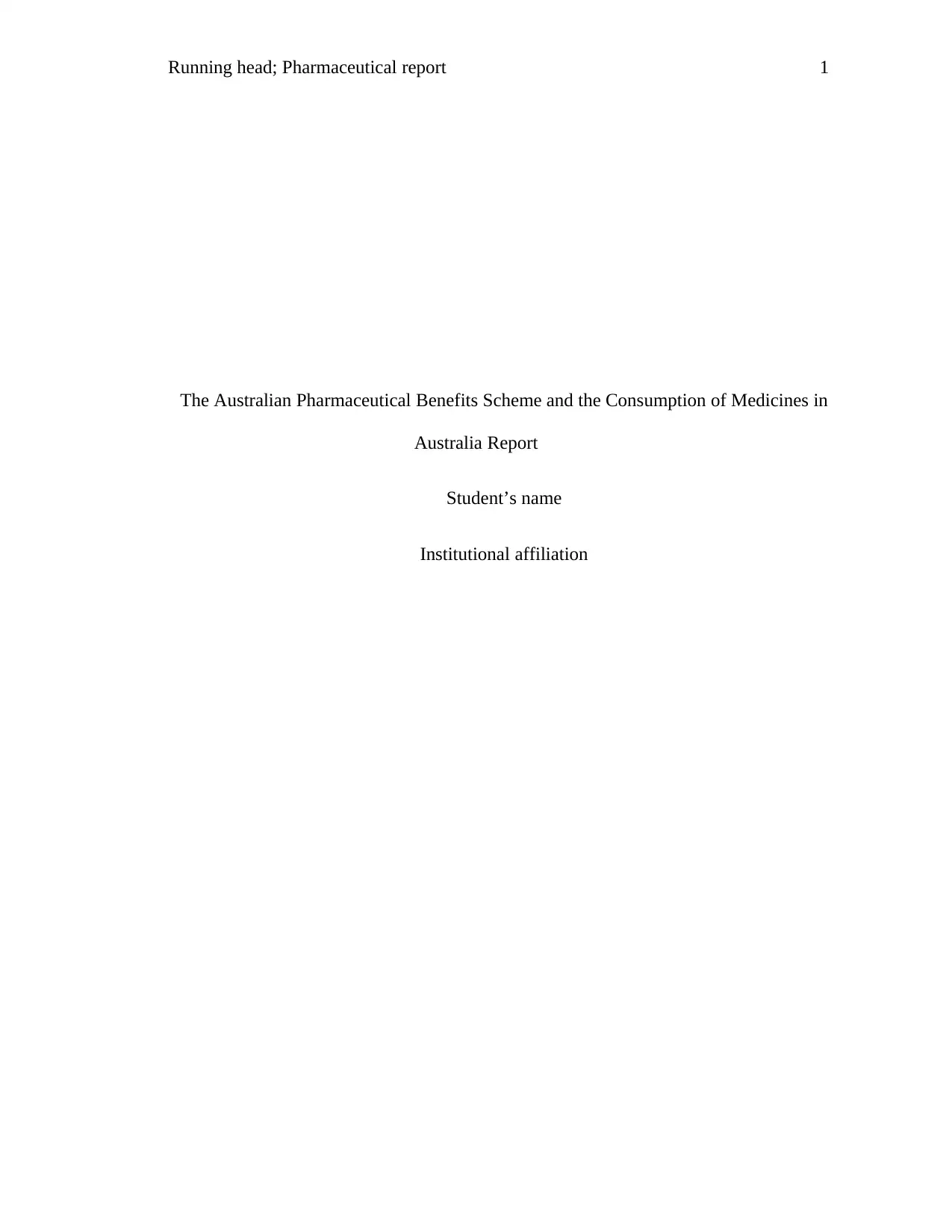
Running head; Pharmaceutical report 1
The Australian Pharmaceutical Benefits Scheme and the Consumption of Medicines in
Australia Report
Student’s name
Institutional affiliation
The Australian Pharmaceutical Benefits Scheme and the Consumption of Medicines in
Australia Report
Student’s name
Institutional affiliation
Paraphrase This Document
Need a fresh take? Get an instant paraphrase of this document with our AI Paraphraser
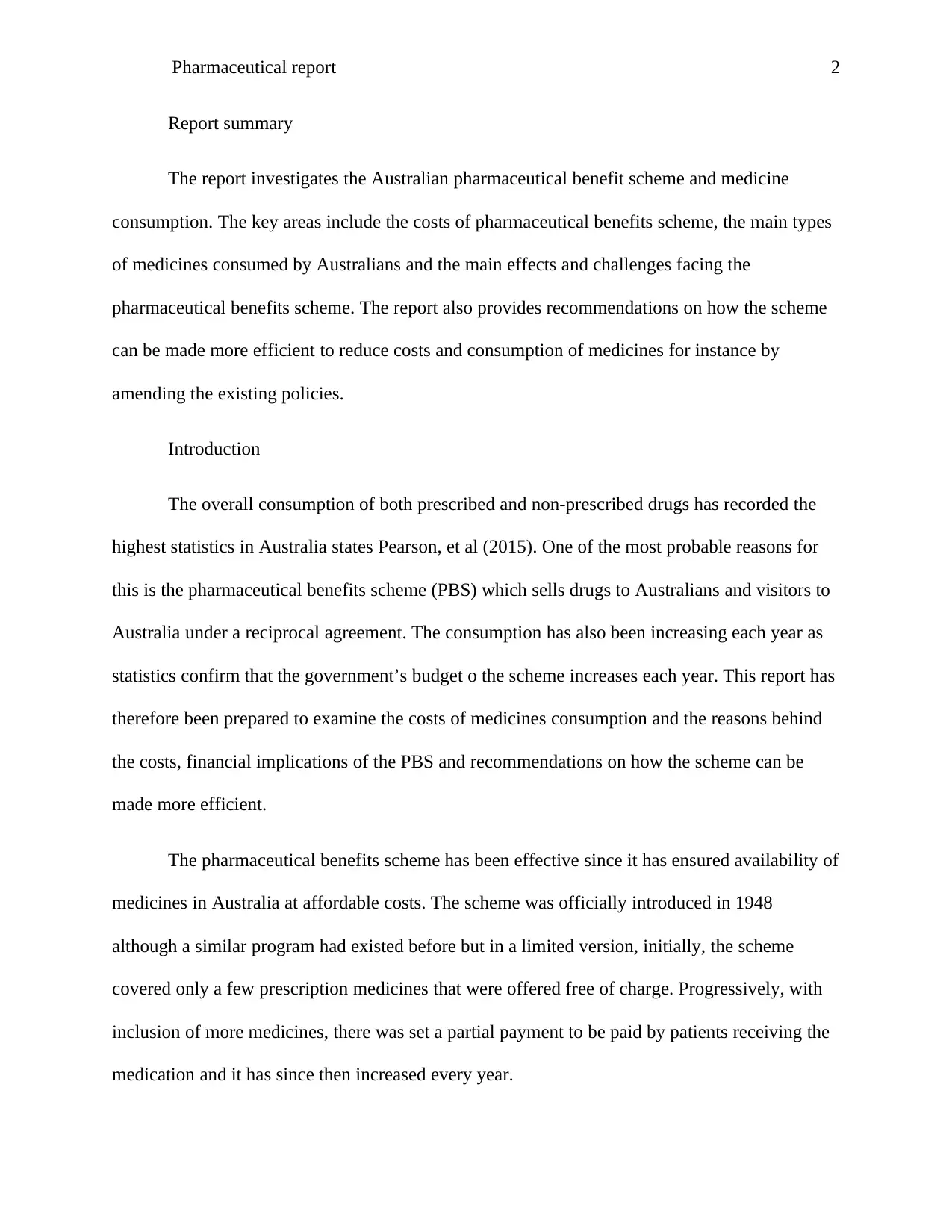
Pharmaceutical report 2
Report summary
The report investigates the Australian pharmaceutical benefit scheme and medicine
consumption. The key areas include the costs of pharmaceutical benefits scheme, the main types
of medicines consumed by Australians and the main effects and challenges facing the
pharmaceutical benefits scheme. The report also provides recommendations on how the scheme
can be made more efficient to reduce costs and consumption of medicines for instance by
amending the existing policies.
Introduction
The overall consumption of both prescribed and non-prescribed drugs has recorded the
highest statistics in Australia states Pearson, et al (2015). One of the most probable reasons for
this is the pharmaceutical benefits scheme (PBS) which sells drugs to Australians and visitors to
Australia under a reciprocal agreement. The consumption has also been increasing each year as
statistics confirm that the government’s budget o the scheme increases each year. This report has
therefore been prepared to examine the costs of medicines consumption and the reasons behind
the costs, financial implications of the PBS and recommendations on how the scheme can be
made more efficient.
The pharmaceutical benefits scheme has been effective since it has ensured availability of
medicines in Australia at affordable costs. The scheme was officially introduced in 1948
although a similar program had existed before but in a limited version, initially, the scheme
covered only a few prescription medicines that were offered free of charge. Progressively, with
inclusion of more medicines, there was set a partial payment to be paid by patients receiving the
medication and it has since then increased every year.
Report summary
The report investigates the Australian pharmaceutical benefit scheme and medicine
consumption. The key areas include the costs of pharmaceutical benefits scheme, the main types
of medicines consumed by Australians and the main effects and challenges facing the
pharmaceutical benefits scheme. The report also provides recommendations on how the scheme
can be made more efficient to reduce costs and consumption of medicines for instance by
amending the existing policies.
Introduction
The overall consumption of both prescribed and non-prescribed drugs has recorded the
highest statistics in Australia states Pearson, et al (2015). One of the most probable reasons for
this is the pharmaceutical benefits scheme (PBS) which sells drugs to Australians and visitors to
Australia under a reciprocal agreement. The consumption has also been increasing each year as
statistics confirm that the government’s budget o the scheme increases each year. This report has
therefore been prepared to examine the costs of medicines consumption and the reasons behind
the costs, financial implications of the PBS and recommendations on how the scheme can be
made more efficient.
The pharmaceutical benefits scheme has been effective since it has ensured availability of
medicines in Australia at affordable costs. The scheme was officially introduced in 1948
although a similar program had existed before but in a limited version, initially, the scheme
covered only a few prescription medicines that were offered free of charge. Progressively, with
inclusion of more medicines, there was set a partial payment to be paid by patients receiving the
medication and it has since then increased every year.
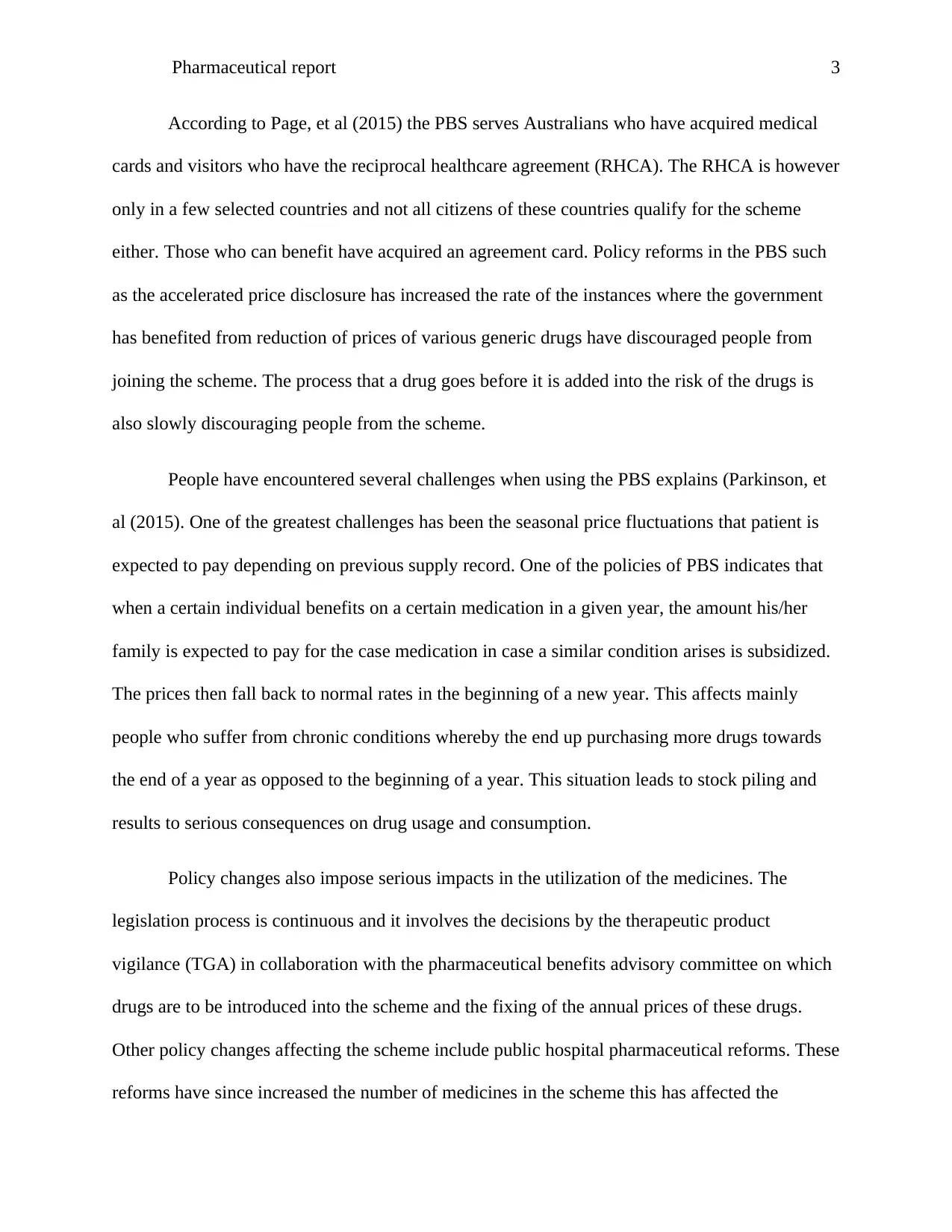
Pharmaceutical report 3
According to Page, et al (2015) the PBS serves Australians who have acquired medical
cards and visitors who have the reciprocal healthcare agreement (RHCA). The RHCA is however
only in a few selected countries and not all citizens of these countries qualify for the scheme
either. Those who can benefit have acquired an agreement card. Policy reforms in the PBS such
as the accelerated price disclosure has increased the rate of the instances where the government
has benefited from reduction of prices of various generic drugs have discouraged people from
joining the scheme. The process that a drug goes before it is added into the risk of the drugs is
also slowly discouraging people from the scheme.
People have encountered several challenges when using the PBS explains (Parkinson, et
al (2015). One of the greatest challenges has been the seasonal price fluctuations that patient is
expected to pay depending on previous supply record. One of the policies of PBS indicates that
when a certain individual benefits on a certain medication in a given year, the amount his/her
family is expected to pay for the case medication in case a similar condition arises is subsidized.
The prices then fall back to normal rates in the beginning of a new year. This affects mainly
people who suffer from chronic conditions whereby the end up purchasing more drugs towards
the end of a year as opposed to the beginning of a year. This situation leads to stock piling and
results to serious consequences on drug usage and consumption.
Policy changes also impose serious impacts in the utilization of the medicines. The
legislation process is continuous and it involves the decisions by the therapeutic product
vigilance (TGA) in collaboration with the pharmaceutical benefits advisory committee on which
drugs are to be introduced into the scheme and the fixing of the annual prices of these drugs.
Other policy changes affecting the scheme include public hospital pharmaceutical reforms. These
reforms have since increased the number of medicines in the scheme this has affected the
According to Page, et al (2015) the PBS serves Australians who have acquired medical
cards and visitors who have the reciprocal healthcare agreement (RHCA). The RHCA is however
only in a few selected countries and not all citizens of these countries qualify for the scheme
either. Those who can benefit have acquired an agreement card. Policy reforms in the PBS such
as the accelerated price disclosure has increased the rate of the instances where the government
has benefited from reduction of prices of various generic drugs have discouraged people from
joining the scheme. The process that a drug goes before it is added into the risk of the drugs is
also slowly discouraging people from the scheme.
People have encountered several challenges when using the PBS explains (Parkinson, et
al (2015). One of the greatest challenges has been the seasonal price fluctuations that patient is
expected to pay depending on previous supply record. One of the policies of PBS indicates that
when a certain individual benefits on a certain medication in a given year, the amount his/her
family is expected to pay for the case medication in case a similar condition arises is subsidized.
The prices then fall back to normal rates in the beginning of a new year. This affects mainly
people who suffer from chronic conditions whereby the end up purchasing more drugs towards
the end of a year as opposed to the beginning of a year. This situation leads to stock piling and
results to serious consequences on drug usage and consumption.
Policy changes also impose serious impacts in the utilization of the medicines. The
legislation process is continuous and it involves the decisions by the therapeutic product
vigilance (TGA) in collaboration with the pharmaceutical benefits advisory committee on which
drugs are to be introduced into the scheme and the fixing of the annual prices of these drugs.
Other policy changes affecting the scheme include public hospital pharmaceutical reforms. These
reforms have since increased the number of medicines in the scheme this has affected the
⊘ This is a preview!⊘
Do you want full access?
Subscribe today to unlock all pages.

Trusted by 1+ million students worldwide
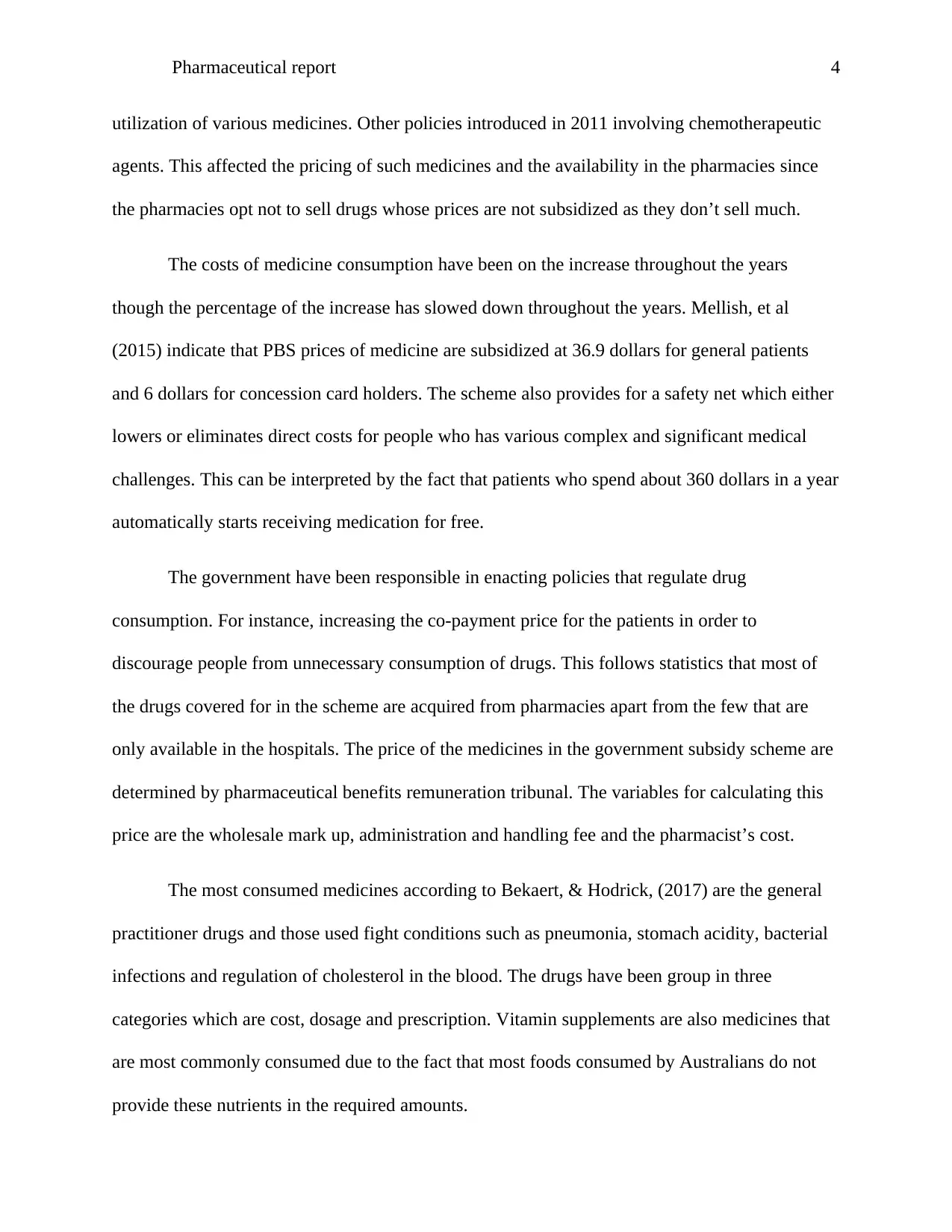
Pharmaceutical report 4
utilization of various medicines. Other policies introduced in 2011 involving chemotherapeutic
agents. This affected the pricing of such medicines and the availability in the pharmacies since
the pharmacies opt not to sell drugs whose prices are not subsidized as they don’t sell much.
The costs of medicine consumption have been on the increase throughout the years
though the percentage of the increase has slowed down throughout the years. Mellish, et al
(2015) indicate that PBS prices of medicine are subsidized at 36.9 dollars for general patients
and 6 dollars for concession card holders. The scheme also provides for a safety net which either
lowers or eliminates direct costs for people who has various complex and significant medical
challenges. This can be interpreted by the fact that patients who spend about 360 dollars in a year
automatically starts receiving medication for free.
The government have been responsible in enacting policies that regulate drug
consumption. For instance, increasing the co-payment price for the patients in order to
discourage people from unnecessary consumption of drugs. This follows statistics that most of
the drugs covered for in the scheme are acquired from pharmacies apart from the few that are
only available in the hospitals. The price of the medicines in the government subsidy scheme are
determined by pharmaceutical benefits remuneration tribunal. The variables for calculating this
price are the wholesale mark up, administration and handling fee and the pharmacist’s cost.
The most consumed medicines according to Bekaert, & Hodrick, (2017) are the general
practitioner drugs and those used fight conditions such as pneumonia, stomach acidity, bacterial
infections and regulation of cholesterol in the blood. The drugs have been group in three
categories which are cost, dosage and prescription. Vitamin supplements are also medicines that
are most commonly consumed due to the fact that most foods consumed by Australians do not
provide these nutrients in the required amounts.
utilization of various medicines. Other policies introduced in 2011 involving chemotherapeutic
agents. This affected the pricing of such medicines and the availability in the pharmacies since
the pharmacies opt not to sell drugs whose prices are not subsidized as they don’t sell much.
The costs of medicine consumption have been on the increase throughout the years
though the percentage of the increase has slowed down throughout the years. Mellish, et al
(2015) indicate that PBS prices of medicine are subsidized at 36.9 dollars for general patients
and 6 dollars for concession card holders. The scheme also provides for a safety net which either
lowers or eliminates direct costs for people who has various complex and significant medical
challenges. This can be interpreted by the fact that patients who spend about 360 dollars in a year
automatically starts receiving medication for free.
The government have been responsible in enacting policies that regulate drug
consumption. For instance, increasing the co-payment price for the patients in order to
discourage people from unnecessary consumption of drugs. This follows statistics that most of
the drugs covered for in the scheme are acquired from pharmacies apart from the few that are
only available in the hospitals. The price of the medicines in the government subsidy scheme are
determined by pharmaceutical benefits remuneration tribunal. The variables for calculating this
price are the wholesale mark up, administration and handling fee and the pharmacist’s cost.
The most consumed medicines according to Bekaert, & Hodrick, (2017) are the general
practitioner drugs and those used fight conditions such as pneumonia, stomach acidity, bacterial
infections and regulation of cholesterol in the blood. The drugs have been group in three
categories which are cost, dosage and prescription. Vitamin supplements are also medicines that
are most commonly consumed due to the fact that most foods consumed by Australians do not
provide these nutrients in the required amounts.
Paraphrase This Document
Need a fresh take? Get an instant paraphrase of this document with our AI Paraphraser
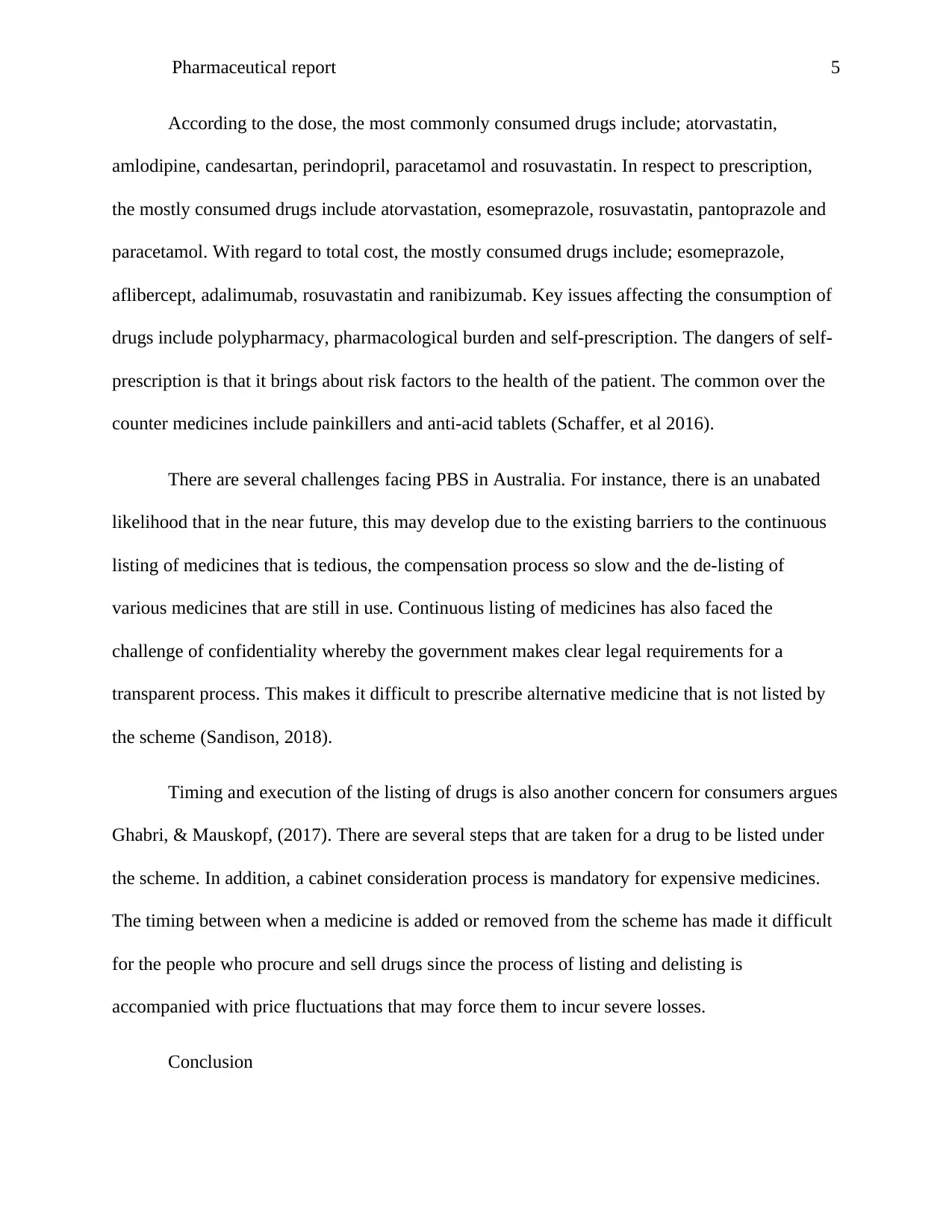
Pharmaceutical report 5
According to the dose, the most commonly consumed drugs include; atorvastatin,
amlodipine, candesartan, perindopril, paracetamol and rosuvastatin. In respect to prescription,
the mostly consumed drugs include atorvastation, esomeprazole, rosuvastatin, pantoprazole and
paracetamol. With regard to total cost, the mostly consumed drugs include; esomeprazole,
aflibercept, adalimumab, rosuvastatin and ranibizumab. Key issues affecting the consumption of
drugs include polypharmacy, pharmacological burden and self-prescription. The dangers of self-
prescription is that it brings about risk factors to the health of the patient. The common over the
counter medicines include painkillers and anti-acid tablets (Schaffer, et al 2016).
There are several challenges facing PBS in Australia. For instance, there is an unabated
likelihood that in the near future, this may develop due to the existing barriers to the continuous
listing of medicines that is tedious, the compensation process so slow and the de-listing of
various medicines that are still in use. Continuous listing of medicines has also faced the
challenge of confidentiality whereby the government makes clear legal requirements for a
transparent process. This makes it difficult to prescribe alternative medicine that is not listed by
the scheme (Sandison, 2018).
Timing and execution of the listing of drugs is also another concern for consumers argues
Ghabri, & Mauskopf, (2017). There are several steps that are taken for a drug to be listed under
the scheme. In addition, a cabinet consideration process is mandatory for expensive medicines.
The timing between when a medicine is added or removed from the scheme has made it difficult
for the people who procure and sell drugs since the process of listing and delisting is
accompanied with price fluctuations that may force them to incur severe losses.
Conclusion
According to the dose, the most commonly consumed drugs include; atorvastatin,
amlodipine, candesartan, perindopril, paracetamol and rosuvastatin. In respect to prescription,
the mostly consumed drugs include atorvastation, esomeprazole, rosuvastatin, pantoprazole and
paracetamol. With regard to total cost, the mostly consumed drugs include; esomeprazole,
aflibercept, adalimumab, rosuvastatin and ranibizumab. Key issues affecting the consumption of
drugs include polypharmacy, pharmacological burden and self-prescription. The dangers of self-
prescription is that it brings about risk factors to the health of the patient. The common over the
counter medicines include painkillers and anti-acid tablets (Schaffer, et al 2016).
There are several challenges facing PBS in Australia. For instance, there is an unabated
likelihood that in the near future, this may develop due to the existing barriers to the continuous
listing of medicines that is tedious, the compensation process so slow and the de-listing of
various medicines that are still in use. Continuous listing of medicines has also faced the
challenge of confidentiality whereby the government makes clear legal requirements for a
transparent process. This makes it difficult to prescribe alternative medicine that is not listed by
the scheme (Sandison, 2018).
Timing and execution of the listing of drugs is also another concern for consumers argues
Ghabri, & Mauskopf, (2017). There are several steps that are taken for a drug to be listed under
the scheme. In addition, a cabinet consideration process is mandatory for expensive medicines.
The timing between when a medicine is added or removed from the scheme has made it difficult
for the people who procure and sell drugs since the process of listing and delisting is
accompanied with price fluctuations that may force them to incur severe losses.
Conclusion
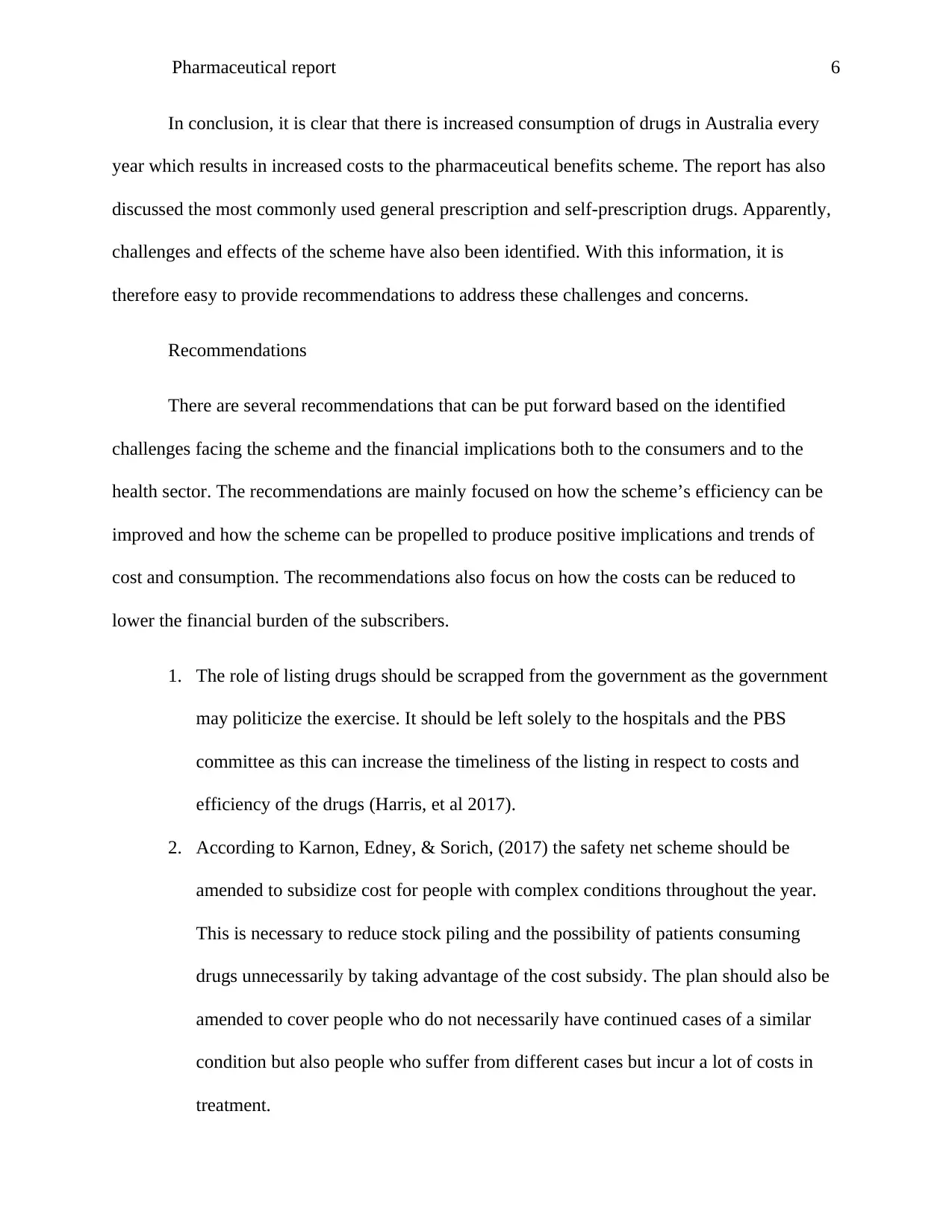
Pharmaceutical report 6
In conclusion, it is clear that there is increased consumption of drugs in Australia every
year which results in increased costs to the pharmaceutical benefits scheme. The report has also
discussed the most commonly used general prescription and self-prescription drugs. Apparently,
challenges and effects of the scheme have also been identified. With this information, it is
therefore easy to provide recommendations to address these challenges and concerns.
Recommendations
There are several recommendations that can be put forward based on the identified
challenges facing the scheme and the financial implications both to the consumers and to the
health sector. The recommendations are mainly focused on how the scheme’s efficiency can be
improved and how the scheme can be propelled to produce positive implications and trends of
cost and consumption. The recommendations also focus on how the costs can be reduced to
lower the financial burden of the subscribers.
1. The role of listing drugs should be scrapped from the government as the government
may politicize the exercise. It should be left solely to the hospitals and the PBS
committee as this can increase the timeliness of the listing in respect to costs and
efficiency of the drugs (Harris, et al 2017).
2. According to Karnon, Edney, & Sorich, (2017) the safety net scheme should be
amended to subsidize cost for people with complex conditions throughout the year.
This is necessary to reduce stock piling and the possibility of patients consuming
drugs unnecessarily by taking advantage of the cost subsidy. The plan should also be
amended to cover people who do not necessarily have continued cases of a similar
condition but also people who suffer from different cases but incur a lot of costs in
treatment.
In conclusion, it is clear that there is increased consumption of drugs in Australia every
year which results in increased costs to the pharmaceutical benefits scheme. The report has also
discussed the most commonly used general prescription and self-prescription drugs. Apparently,
challenges and effects of the scheme have also been identified. With this information, it is
therefore easy to provide recommendations to address these challenges and concerns.
Recommendations
There are several recommendations that can be put forward based on the identified
challenges facing the scheme and the financial implications both to the consumers and to the
health sector. The recommendations are mainly focused on how the scheme’s efficiency can be
improved and how the scheme can be propelled to produce positive implications and trends of
cost and consumption. The recommendations also focus on how the costs can be reduced to
lower the financial burden of the subscribers.
1. The role of listing drugs should be scrapped from the government as the government
may politicize the exercise. It should be left solely to the hospitals and the PBS
committee as this can increase the timeliness of the listing in respect to costs and
efficiency of the drugs (Harris, et al 2017).
2. According to Karnon, Edney, & Sorich, (2017) the safety net scheme should be
amended to subsidize cost for people with complex conditions throughout the year.
This is necessary to reduce stock piling and the possibility of patients consuming
drugs unnecessarily by taking advantage of the cost subsidy. The plan should also be
amended to cover people who do not necessarily have continued cases of a similar
condition but also people who suffer from different cases but incur a lot of costs in
treatment.
⊘ This is a preview!⊘
Do you want full access?
Subscribe today to unlock all pages.

Trusted by 1+ million students worldwide
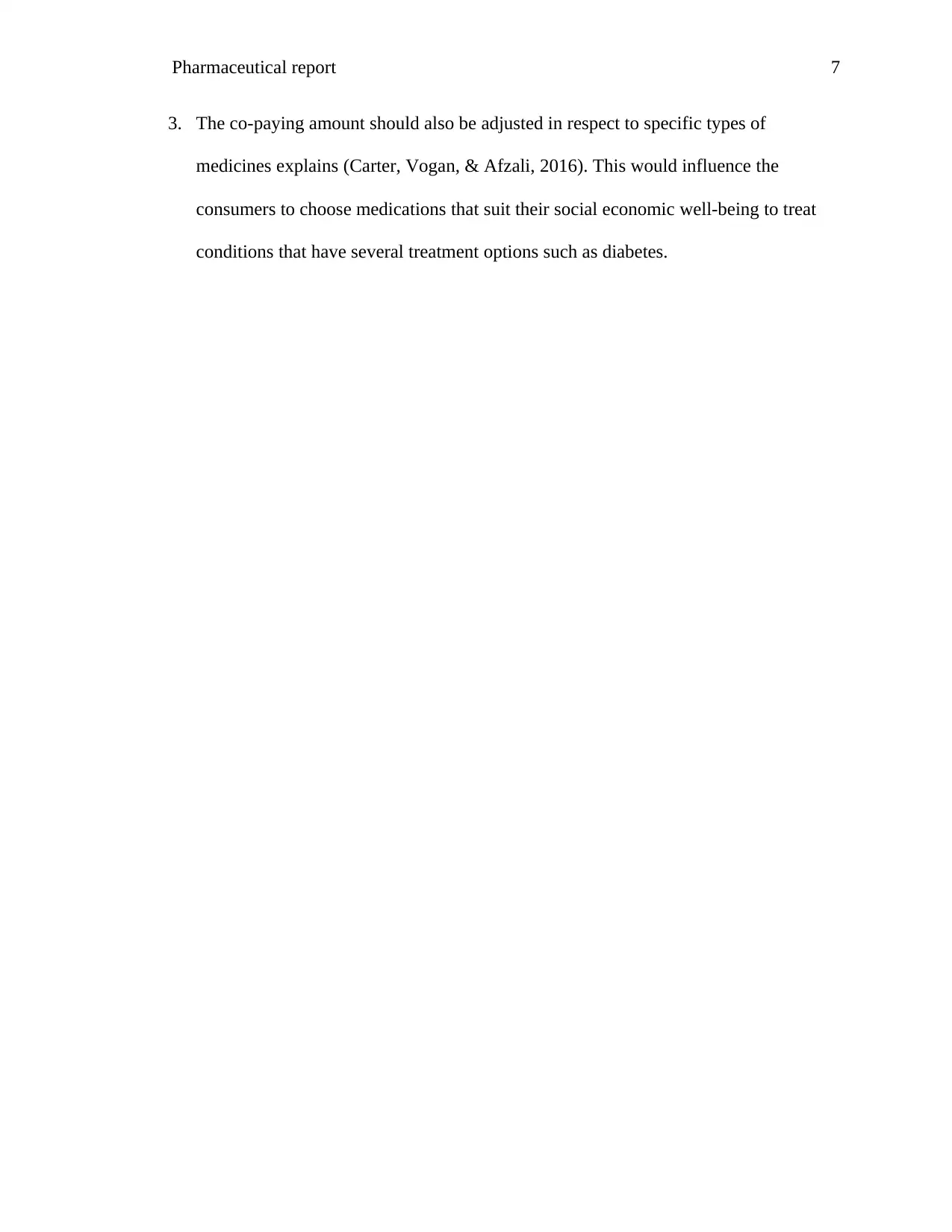
Pharmaceutical report 7
3. The co-paying amount should also be adjusted in respect to specific types of
medicines explains (Carter, Vogan, & Afzali, 2016). This would influence the
consumers to choose medications that suit their social economic well-being to treat
conditions that have several treatment options such as diabetes.
3. The co-paying amount should also be adjusted in respect to specific types of
medicines explains (Carter, Vogan, & Afzali, 2016). This would influence the
consumers to choose medications that suit their social economic well-being to treat
conditions that have several treatment options such as diabetes.
Paraphrase This Document
Need a fresh take? Get an instant paraphrase of this document with our AI Paraphraser
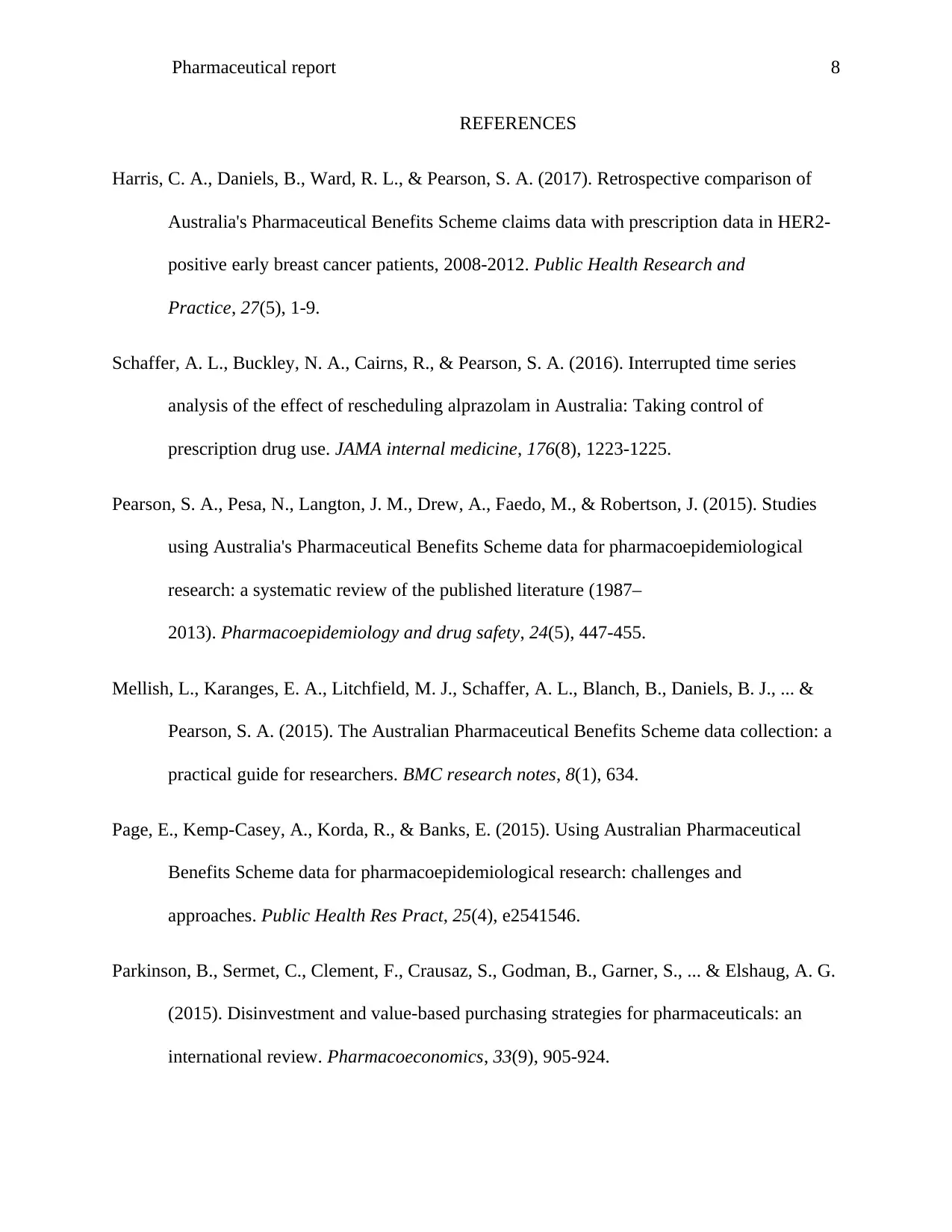
Pharmaceutical report 8
REFERENCES
Harris, C. A., Daniels, B., Ward, R. L., & Pearson, S. A. (2017). Retrospective comparison of
Australia's Pharmaceutical Benefits Scheme claims data with prescription data in HER2-
positive early breast cancer patients, 2008-2012. Public Health Research and
Practice, 27(5), 1-9.
Schaffer, A. L., Buckley, N. A., Cairns, R., & Pearson, S. A. (2016). Interrupted time series
analysis of the effect of rescheduling alprazolam in Australia: Taking control of
prescription drug use. JAMA internal medicine, 176(8), 1223-1225.
Pearson, S. A., Pesa, N., Langton, J. M., Drew, A., Faedo, M., & Robertson, J. (2015). Studies
using Australia's Pharmaceutical Benefits Scheme data for pharmacoepidemiological
research: a systematic review of the published literature (1987–
2013). Pharmacoepidemiology and drug safety, 24(5), 447-455.
Mellish, L., Karanges, E. A., Litchfield, M. J., Schaffer, A. L., Blanch, B., Daniels, B. J., ... &
Pearson, S. A. (2015). The Australian Pharmaceutical Benefits Scheme data collection: a
practical guide for researchers. BMC research notes, 8(1), 634.
Page, E., Kemp-Casey, A., Korda, R., & Banks, E. (2015). Using Australian Pharmaceutical
Benefits Scheme data for pharmacoepidemiological research: challenges and
approaches. Public Health Res Pract, 25(4), e2541546.
Parkinson, B., Sermet, C., Clement, F., Crausaz, S., Godman, B., Garner, S., ... & Elshaug, A. G.
(2015). Disinvestment and value-based purchasing strategies for pharmaceuticals: an
international review. Pharmacoeconomics, 33(9), 905-924.
REFERENCES
Harris, C. A., Daniels, B., Ward, R. L., & Pearson, S. A. (2017). Retrospective comparison of
Australia's Pharmaceutical Benefits Scheme claims data with prescription data in HER2-
positive early breast cancer patients, 2008-2012. Public Health Research and
Practice, 27(5), 1-9.
Schaffer, A. L., Buckley, N. A., Cairns, R., & Pearson, S. A. (2016). Interrupted time series
analysis of the effect of rescheduling alprazolam in Australia: Taking control of
prescription drug use. JAMA internal medicine, 176(8), 1223-1225.
Pearson, S. A., Pesa, N., Langton, J. M., Drew, A., Faedo, M., & Robertson, J. (2015). Studies
using Australia's Pharmaceutical Benefits Scheme data for pharmacoepidemiological
research: a systematic review of the published literature (1987–
2013). Pharmacoepidemiology and drug safety, 24(5), 447-455.
Mellish, L., Karanges, E. A., Litchfield, M. J., Schaffer, A. L., Blanch, B., Daniels, B. J., ... &
Pearson, S. A. (2015). The Australian Pharmaceutical Benefits Scheme data collection: a
practical guide for researchers. BMC research notes, 8(1), 634.
Page, E., Kemp-Casey, A., Korda, R., & Banks, E. (2015). Using Australian Pharmaceutical
Benefits Scheme data for pharmacoepidemiological research: challenges and
approaches. Public Health Res Pract, 25(4), e2541546.
Parkinson, B., Sermet, C., Clement, F., Crausaz, S., Godman, B., Garner, S., ... & Elshaug, A. G.
(2015). Disinvestment and value-based purchasing strategies for pharmaceuticals: an
international review. Pharmacoeconomics, 33(9), 905-924.
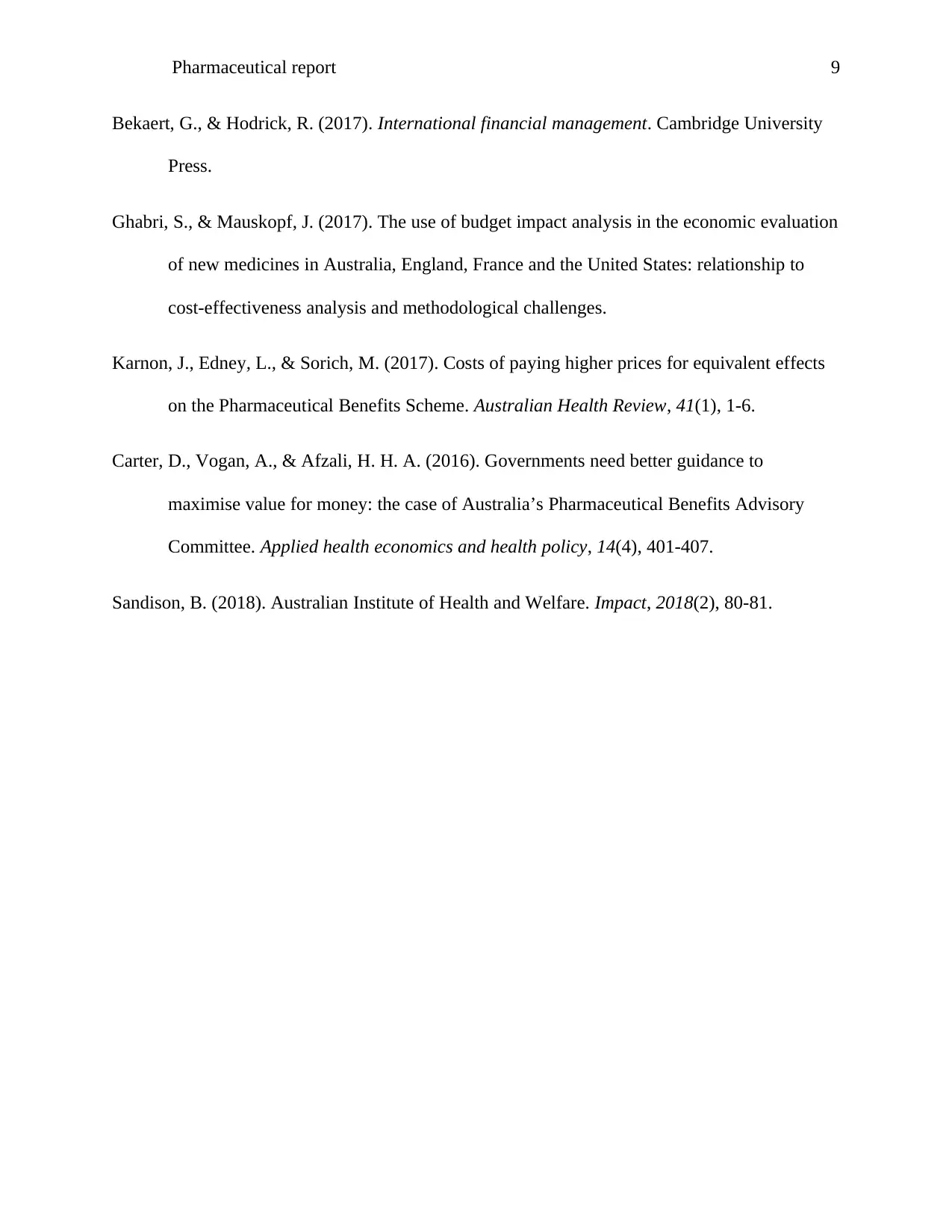
Pharmaceutical report 9
Bekaert, G., & Hodrick, R. (2017). International financial management. Cambridge University
Press.
Ghabri, S., & Mauskopf, J. (2017). The use of budget impact analysis in the economic evaluation
of new medicines in Australia, England, France and the United States: relationship to
cost-effectiveness analysis and methodological challenges.
Karnon, J., Edney, L., & Sorich, M. (2017). Costs of paying higher prices for equivalent effects
on the Pharmaceutical Benefits Scheme. Australian Health Review, 41(1), 1-6.
Carter, D., Vogan, A., & Afzali, H. H. A. (2016). Governments need better guidance to
maximise value for money: the case of Australia’s Pharmaceutical Benefits Advisory
Committee. Applied health economics and health policy, 14(4), 401-407.
Sandison, B. (2018). Australian Institute of Health and Welfare. Impact, 2018(2), 80-81.
Bekaert, G., & Hodrick, R. (2017). International financial management. Cambridge University
Press.
Ghabri, S., & Mauskopf, J. (2017). The use of budget impact analysis in the economic evaluation
of new medicines in Australia, England, France and the United States: relationship to
cost-effectiveness analysis and methodological challenges.
Karnon, J., Edney, L., & Sorich, M. (2017). Costs of paying higher prices for equivalent effects
on the Pharmaceutical Benefits Scheme. Australian Health Review, 41(1), 1-6.
Carter, D., Vogan, A., & Afzali, H. H. A. (2016). Governments need better guidance to
maximise value for money: the case of Australia’s Pharmaceutical Benefits Advisory
Committee. Applied health economics and health policy, 14(4), 401-407.
Sandison, B. (2018). Australian Institute of Health and Welfare. Impact, 2018(2), 80-81.
⊘ This is a preview!⊘
Do you want full access?
Subscribe today to unlock all pages.

Trusted by 1+ million students worldwide
1 out of 9
Related Documents
Your All-in-One AI-Powered Toolkit for Academic Success.
+13062052269
info@desklib.com
Available 24*7 on WhatsApp / Email
![[object Object]](/_next/static/media/star-bottom.7253800d.svg)
Unlock your academic potential
Copyright © 2020–2025 A2Z Services. All Rights Reserved. Developed and managed by ZUCOL.



